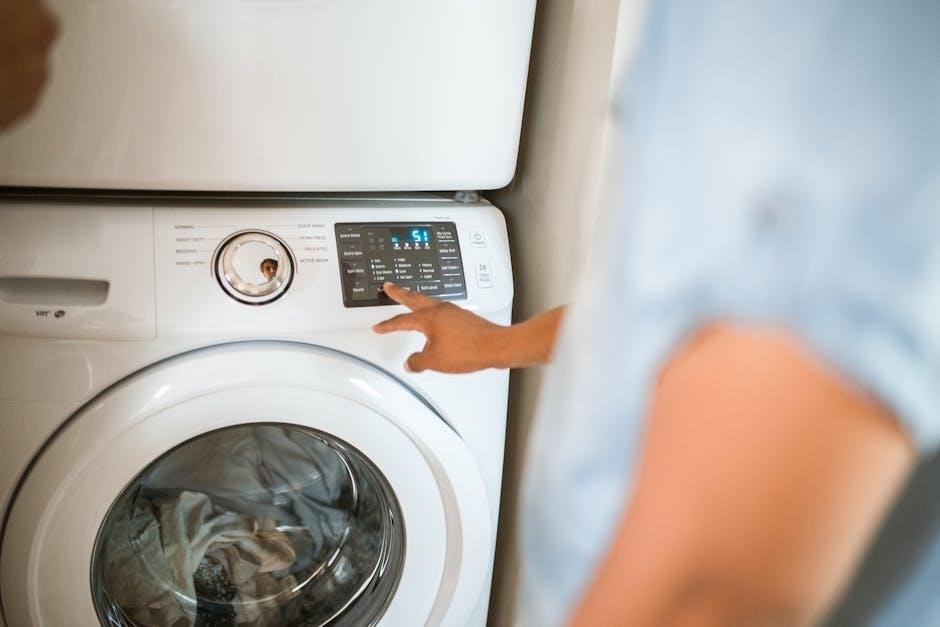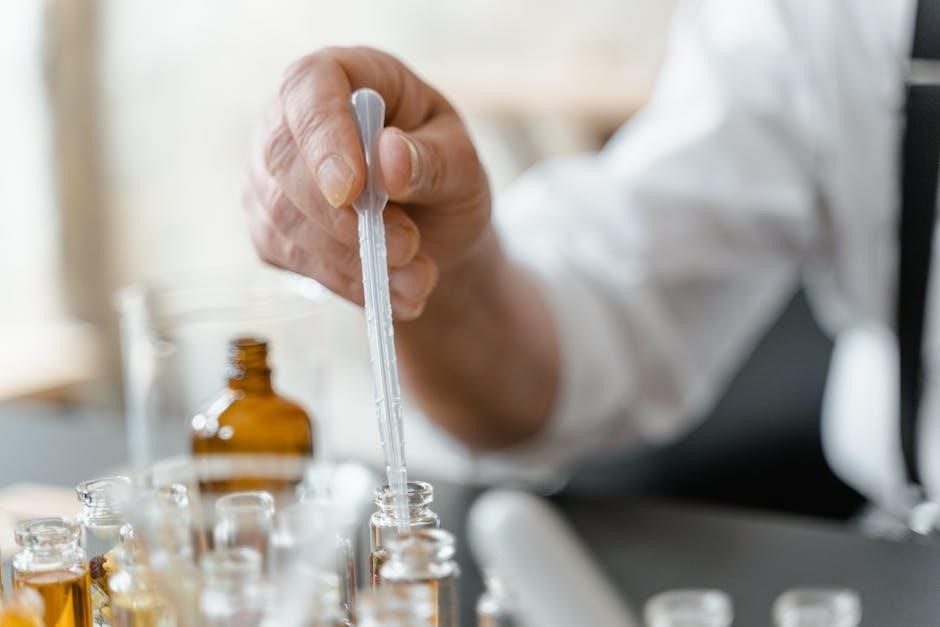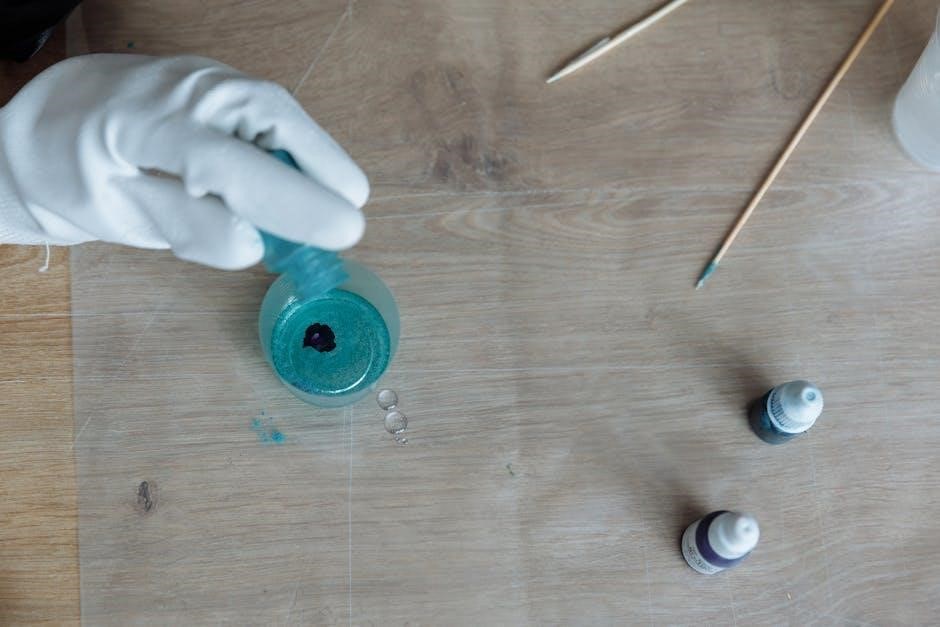Martin’s Permethrin 13․3 is a multi-purpose insecticide for indoor and outdoor use, controlling pests like ticks and insects for up to four weeks․ It’s ideal for homes, farms, and livestock, offering versatile applications and effective pest control solutions․
1․1 Overview of Permethrin 13․3
Martin’s Permethrin 13․3 is a multi-purpose insecticide designed for both indoor and outdoor use, providing effective control of ticks, roaches, and other pests for up to four weeks․ It is widely used in homes, farms, and on livestock, including cattle, horses, and poultry․ The product is versatile, allowing applications on surfaces, clothing, and animals․ Its efficacy makes it a popular choice for controlling a variety of insect pests, ensuring protection and comfort in diverse settings․ Proper mixing is essential to maximize its effectiveness and safety․
1․2 Importance of Proper Mixing Instructions
Proper mixing of Martin’s Permethrin 13․3 is crucial for its effectiveness and safety․ Incorrect dilution can lead to reduced pest control or potential harm to people, animals, or the environment․ Following the recommended ratios, such as 2 2/3 to 5 1/2 oz per gallon for ticks, ensures optimal results․ Improper mixing may result in under-application, reducing efficacy, or over-application, posing health risks․ Always adhere to the product label and safety guidelines to achieve desired outcomes and minimize hazards․ Proper preparation is essential for safe and effective pest management․
Understanding the Product
Martin’s Permethrin 13․3 is a synthetic insecticide for broad-spectrum pest control, offering effective treatment on surfaces, clothing, and animals․ It targets ticks, mosquitoes, fleas, and mites․
2․1 Active Ingredients in Permethrin 13․3
Martin’s Permethrin 13․3 contains permethrin as its active ingredient, a synthetic pyrethroid that mimics natural insecticides found in chrysanthemum flowers․ At 13․3%, it is a concentrated formula designed for versatility across various applications․ Permethrin works by disrupting the nervous system of insects, leading to paralysis and death․ It is effective against a wide range of pests, including ticks, mosquitoes, fleas, and mites․ The product is labeled for use on livestock, poultry, and outdoor areas, making it a reliable choice for both agricultural and residential pest control needs․ Always follow label instructions for safe and effective use․
2․2 Uses of Permethrin 13․3
Martin’s Permethrin 13․3 is a versatile insecticide used for controlling a wide range of pests․ It is commonly applied to livestock, including cattle, swine, and poultry, to manage ticks, flies, and lice․ Additionally, it is used on agricultural premises, such as barns and feedlots, to target pests that infest these areas․ The product is also effective for treating outdoor spaces, like lawns and gardens, to control mosquitoes, fleas, and other nuisance insects․ Its broad-spectrum activity makes it a reliable solution for both agricultural and residential pest management needs․
2․3 Target Pests and Applications
Martin’s Permethrin 13․3 is specifically designed to control a variety of pests, including ticks, mosquitoes, flies, fleas, and lice․ It is primarily used on livestock such as cattle, swine, and poultry to prevent infestations․ The product is also effective for treating agricultural premises, barns, and pasture areas to eliminate pests that can harm animals or damage crops․ Additionally, it can be applied to outdoor recreational spaces to reduce nuisance insect populations, making it a versatile solution for both agricultural and outdoor pest control needs․

General Mixing Instructions
Martin’s Permethrin 13․3 should be mixed with water according to the label’s instructions to ensure proper dilution and application․ Always follow safety guidelines and use appropriate equipment to mix accurately․
3․1 Basic Mixing Ratios
Martin’s Permethrin 13․3 is typically mixed at a rate of 1 to 3 pints per 100 gallons of water, depending on the target pest and application site․ For general insect control, a 1:100 ratio is common, while tick control may require a higher concentration of 2 to 3 pints per 100 gallons․ Always refer to the product label for specific dilution rates tailored to your application․ Using a calibrated spray system ensures accurate mixing and avoids over- or under-dilution, which can affect efficacy or safety․
3․2 Equipment Needed for Mixing
To ensure safe and effective mixing of Martin’s Permethrin 13․3, gather the necessary equipment․ A clean, food-grade container with a lid is essential for mixing․ Use a water source with a known volume, such as a 50-gallon tank, to maintain accurate ratios․ Measuring cups or jugs, a stir stick, and protective gear like gloves and goggles are critical․ A calibrated sprayer or application device is also required․ Ensure all equipment is free from contamination and properly cleaned before use to prevent cross-contamination and maintain product efficacy․
3․3 Steps to Prepare the Solution
Start by ensuring all equipment is clean and in good condition․ Add water to the mixing container, leaving space for the Permethrin 13․3․ Measure the recommended amount of Permethrin 13․3 using the provided gauge or a calibrated measuring device․ Slowly pour the product into the water while stirring to prevent foaming; Continue stirring until the solution is fully dissolved․ Allow the mixture to sit for a few minutes before transferring it to the application device․ Always mix in a well-ventilated area and avoid splashing․

Safety Precautions
Always wear protective clothing, gloves, and eyewear․ Work in a well-ventilated area to avoid inhaling fumes․ Avoid skin contact and wash hands thoroughly after handling․
4․1 Personal Protective Equipment (PPE)
When mixing or applying Martin’s Permethrin 13․3, wear long sleeves, pants, and closed-toe shoes․ Use chemical-resistant gloves, goggles, and a face shield to prevent skin and eye contact․ A respirator with an organic vapor cartridge is recommended to avoid inhaling fumes․ Ensure all PPE meets EPA standards for pesticide handling․ Remove contaminated clothing immediately and wash thoroughly after use to minimize exposure risks․
4․2 Handling Precautions
Handle Martin’s Permethrin 13․3 with care to avoid exposure․ Keep the product away from food, water sources, and pets․ Avoid eating, drinking, or smoking during mixing or application․ Work in a well-ventilated area to prevent inhaling vapors․ If spills occur, contain them immediately using absorbent materials like sand or sawdust, and dispose of properly․ Prevent skin contact by washing hands thoroughly after handling․ Ensure the area is clear of unnecessary personnel to minimize accidental exposure risks․
4․3 Emergency Procedures
In case of accidental exposure, immediately rinse affected areas with plenty of water․ For skin contact, wash with soap and water․ If permethrin gets in the eyes, flush thoroughly with water for at least 15 minutes․ Seek medical attention if irritation persists․ In case of ingestion or inhalation, contact a poison control center or doctor promptly․ For spills, neutralize the area with soda ash and water, then dispose of according to regulations․ Keep the product away from open flames, as it may be flammable․ Store out of reach of children and pets․

Application Methods
- Use handheld pump sprayers for small areas or targeted applications․
- Employ automatic spray systems for larger-scale treatments․
- Foggers are ideal for enclosed spaces or dense vegetation․
- Ensure even coverage for optimal effectiveness․
- Always follow label instructions for specific application guidelines․
5․1 Handheld Pump Sprayers
Handheld pump sprayers are ideal for small-scale applications or targeted treatments․ They offer precise control over the amount of solution applied, making them suitable for gardens, outdoor gear, or small areas․ Fill the sprayer with the prepared permethrin solution, ensuring the nozzle is adjusted for the desired spray pattern․ Pump the sprayer according to the manufacturer’s instructions to maintain pressure․ Apply the solution evenly, avoiding excessive runoff․ For best results, use in calm conditions to prevent drift․ This method is cost-effective and easy to use for residential or personal applications․
5․2 Automatic Spray Systems
Automatic spray systems are ideal for large-scale applications, offering efficiency and uniform coverage․ These systems typically include a tank, pump, and nozzle setup, designed for consistent application rates․ Ensure the system is calibrated to deliver the correct dilution ratio as specified on the label․ Automatic sprayers are particularly useful for treating extensive areas like barns, fences, or vegetation․ They save time and reduce manual effort, making them a practical choice for professionals or those managing large properties․ Always follow the manufacturer’s guidelines for setup and operation to ensure optimal results and safety․
5․3 Foggers and Other Equipment
Foggers and other specialized equipment are effective for applying Martin’s Permethrin 13․3 in large or hard-to-reach areas․ Foggers create a fine mist, ensuring thorough coverage in outdoor spaces or barns․ Always calibrate the equipment according to the manufacturer’s instructions to maintain the correct dilution ratio․ Adjust nozzles to achieve the desired droplet size for optimal application․ For safety, avoid exposure during operation and ensure the area is vacated until the mist has settled․ Other equipment, like misting machines, should also be used in accordance with the product label for best results․

Dilution Rates for Specific Uses
Martin’s Permethrin 13․3 requires precise dilution rates for different applications, ensuring effectiveness and safety․ Always follow label instructions for specific use cases to achieve optimal results․
6․1 Dilution for Tick Control
For effective tick control, mix Martin’s Permethrin 13․3 at a rate of 1 ounce per gallon of water․ This concentration ensures optimal tick elimination without excessive chemical use․ Apply the solution to areas where ticks are prevalent, such as shrubs, grass, and leaf litter․ Use a backpack or handheld sprayer to evenly distribute the mixture․ Ensure thorough coverage but avoid over-saturation․ Repeat application every 28 days or after heavy rain to maintain effectiveness․ Always follow label instructions for best results and safety․
6․2 Dilution for General Insect Control
For general insect control, mix Martin’s Permethrin 13․3 at a rate of 2 ounces per gallon of water․ This concentration is effective against a wide range of insects, including mosquitoes, flies, and spiders․ Apply the solution to surfaces, gardens, or outdoor areas where insects are present․ Use a sprayer to ensure even coverage․ Avoid over-application to prevent runoff․ Repeat every 21 to 28 days for sustained control․ Always adhere to the label instructions for safe and effective use․
6․3 Dilution for Livestock and Poultry
For livestock and poultry, mix Martin’s Permethrin 13․3 at a rate of 1 ounce per gallon of water․ This solution effectively controls horn flies, lice, and mites on cattle, swine, and poultry․ Apply using a sprayer, ensuring thorough coverage of animals and living areas․ Avoid application on stressed or sick animals․ Do not use on animals intended for dairy․ Repeat as needed, but not more than every 10 days․ Always follow label instructions for safe and effective pest control․

Common Applications
Martin’s Permethrin 13;3 is widely used for controlling pests in homes, barns, and on livestock․ It effectively treats clothing and gear for tick and insect repellency outdoors․
7․1 Indoor Applications
Martin’s Permethrin 13․3 is commonly used indoors to control pests in homes, apartments, basements, and barns․ It effectively targets fleas, ticks, and mosquitoes․ For indoor use, mix the solution according to the label instructions and apply it to floors, walls, and surfaces where pests are present․ Avoid spraying on furniture or carpets․ Allow the treated areas to dry completely before reuse․ This ensures safety and effectiveness in indoor pest management․ Always follow safety precautions to minimize exposure during application․
7․2 Outdoor Applications
Martin’s Permethrin 13․3 is effective for outdoor pest control, targeting mosquitoes, ticks, and flies․ It can be applied to lawns, shrubs, trees, and outdoor living areas․ For yard treatments, mix the solution according to label instructions and use a hand sprayer or backpack sprayer․ Apply evenly, ensuring coverage of all surfaces․ Avoid spraying during peak sun hours to prevent rapid evaporation․ Regular outdoor applications help reduce pest populations and create a safer environment for outdoor activities․ Always follow safety guidelines and recommended dilution rates for optimal results․
7․3 Applications on Animals
Martin’s Permethrin 13․3 is commonly used on livestock and poultry to control external parasites like ticks, lice, and mites․ For animals, the solution is typically applied using a sprayer or sponge․ Ensure thorough coverage of the animal’s coat, paying attention to areas where pests are most prevalent․ Always follow the recommended dilution rate for animal applications to avoid over-application․ Consult the product label or a veterinarian for specific guidance, especially for sensitive or young animals․ Proper application helps protect animals from pest-related stress and disease transmission․
7․4 Applications on Clothing
Permethrin 13․3 can be applied to clothing to repel insects like mosquitoes and ticks․ Dilute the product according to label instructions, typically 1-2% concentration․ Use a spray bottle to evenly apply the solution to fabric surfaces․ Allow the clothing to air dry completely before wear․ This treatment can remain effective for up to six washes․ Avoid direct skin contact and wash hands thoroughly after handling treated clothing․ Always follow safety guidelines to ensure proper use and effectiveness․

Storage and Disposal
Store Martin’s Permethrin 13․3 in a cool, dry place away from direct sunlight and heat sources․ Dispose of unused product and empty containers according to local regulations․
8․1 Proper Storage Conditions
Martin’s Permethrin 13․3 should be stored in a cool, dry, well-ventilated area away from direct sunlight and heat sources․ Keep the container tightly sealed and protected from moisture․ Avoid storing near open flames, sparks, or ignition sources․ The ideal storage temperature is between 40°F and 90°F (4°C and 32°C)․ Ensure the product is out of reach of children, pets, and unauthorized personnel․ Store in an area separate from food, feed, and other chemicals to prevent contamination․ Always follow the label instructions for storage to maintain product effectiveness and safety․
8․2 Disposal Guidelines
Dispose of Martin’s Permethrin 13․3 and its container in accordance with federal, state, and local regulations․ Do not dispose of the product down drains, sewers, or into waterways to avoid environmental contamination․ Triple rinse the empty container and recycle it if allowed by local guidelines․ Unused product should be treated as hazardous waste and disposed of through authorized facilities․ Always follow the label instructions and consult local authorities for specific disposal requirements to ensure compliance and environmental safety․
8․3 Environmental Considerations
Martin’s Permethrin 13․3 should be used responsibly to minimize environmental impact; Avoid spraying near water sources, including ponds, lakes, or rivers, to protect aquatic life․ Prevent runoff by not applying the product before heavy rain․ Ensure the product is not applied in a way that could contaminate soil or water systems․ Follow label instructions to reduce ecological risks and promote environmental safety․ Proper use helps protect wildlife and maintains ecosystem balance while effectively managing pests․

Frequently Asked Questions
Common questions about Martin’s Permethrin 13․3 include optimal dilution rates, solution longevity, and compatibility with other chemicals, ensuring safe and effective pest control applications․
9․1 How Much Water Should I Use?
Martin’s Permethrin 13․3 is typically mixed at a rate of 1 to 2 ounces per gallon of water, depending on the target pest and application site․ For general insect control, 1 ounce per gallon is sufficient, while 2 ounces per gallon is recommended for heavier infestations or ticks․ Always follow the label instructions to ensure proper dilution and effectiveness․ Using too much water can reduce efficacy, while over-concentrating the solution may pose safety risks․ Adjust the water volume according to the treatment area to maintain the correct ratio․
9․2 Can I Mix Permethrin 13․3 with Other Chemicals?
Martin’s Permethrin 13․3 should not be mixed with other chemicals unless specified on the label or by a qualified professional․ Incompatible mixtures can reduce effectiveness or cause phytotoxicity․ Always consult the product label or contact a pest control expert before combining with fertilizers, herbicides, or fungicides․ Improper mixing may void the product warranty or pose environmental risks․ Adhere to label instructions to ensure safe and effective application․
9․3 How Long Does the Solution Remain Effective?
Martin’s Permethrin 13․3 solution typically remains effective for up to 30 days, depending on environmental conditions․ Factors like sunlight, rain, and temperature can impact its longevity․ For optimal results, use the mixed solution within 24 hours and store any leftovers in a sealed container․ Avoid exposure to direct sunlight or extreme temperatures to maintain potency․ Always reapply as needed based on pest activity or weather conditions to ensure continued effectiveness․

Troubleshooting Common Mixing Mistakes
Identify and resolve errors in permethrin mixing, such as incorrect ratios or improper techniques, to ensure effective application and safety․ Address issues promptly for best results․
10․1 Incorrect Dilution Ratios
Incorrect dilution ratios are a common mistake when mixing Martin’s Permethrin 13․3․ Using too little or too much active ingredient can reduce effectiveness or pose environmental risks․ Under-dilution may lead to insufficient pest control, while over-dilution can harm plants or animals․ Always follow the label’s recommended ratios to ensure proper concentration․ Double-check measurements before mixing to avoid errors․ If unsure, consult the product label or use a dilution calculator for precise mixing․ Proper dilution ensures safety and efficacy in pest management applications․
10․2 Improper Mixing Techniques
Improper mixing techniques can significantly affect the effectiveness and safety of Martin’s Permethrin 13․3․ Common errors include not following the recommended order of adding ingredients, such as adding the product to water improperly․ Using contaminated water or failing to agitate the solution thoroughly can lead to uneven distribution of the active ingredient․ This may result in reduced efficacy or potential risks to people, animals, or the environment․ Always follow the label instructions carefully to ensure proper mixing and application․
10․3 Over- or Under-application
Over- or under-application of Martin’s Permethrin 13․3 can lead to reduced effectiveness or environmental risks․ Over-application may result in wasted product, potential runoff, or harm to non-target organisms․ Under-application can fail to control pests adequately, leading to infestation persistence․ Always adhere to the recommended dilution rates and application guidelines to ensure optimal results while minimizing risks․ Proper calibration of equipment and accurate measurement are crucial to avoid these common mixing mistakes․

Regulatory Information
Martin’s Permethrin 13․3 must comply with EPA regulations and state laws․ Always follow label instructions to ensure legal and safe use of the product․
11․1 EPA Regulations and Compliance
Martin’s Permethrin 13․3 is registered with the EPA, ensuring it meets strict safety and environmental standards․ Users must adhere to label instructions to maintain compliance, including proper mixing ratios, application rates, and safety precautions․ Failure to comply can result in legal consequences and may harm the environment․ Always verify the product’s EPA registration number and follow all federal and state guidelines for responsible use․
11․2 Label Instructions and Compliance
Adhering to the label instructions for Martin’s Permethrin 13․3 is crucial for legal and safe use․ The label provides detailed mixing ratios, application rates, and safety guidelines that must be followed to ensure effectiveness and minimize risks․ Non-compliance can result in legal consequences, environmental harm, or reduced product performance․ Always read and follow the label carefully, as it is a legal document․ Proper record-keeping of applications and mixing procedures is also recommended for compliance verification during inspections․
11․3 State and Local Regulations
State and local regulations may impose additional requirements for using Martin’s Permethrin 13․3․ These can include specific application restrictions, permit requirements, or reporting obligations․ It is essential to verify local laws before use to ensure compliance․ Some jurisdictions may have stricter guidelines than federal regulations, especially in environmentally sensitive areas․ Failure to comply with state or local rules can result in fines or legal action․ Always consult local authorities to confirm permissible uses and application limits in your region․
Martin’s Permethrin 13․3 is a versatile and effective solution for pest control when used correctly․ Proper mixing, application, and adherence to safety guidelines are crucial for optimal results․ Always follow the labeled instructions and consult local regulations to ensure compliance․ By understanding the product’s strengths and limitations, users can safely and efficiently manage pests in various settings․ Proper storage, disposal, and environmental awareness further enhance the responsible use of this valuable pest control tool․




